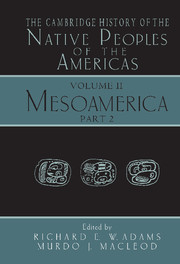Book contents
- Frontmatter
- 12 Mesoamerica Since the Spanish Invasion: an Overview
- 13 Legacies of Resistance, Adaptation, and Tenacity: History of the Native Peoples of Northwest Mexico
- 14 The Native Peoples of Northeastern Mexico
- 15 The Indigenous Peoples of Western Mexico from the Spanish Invasion to the Present
- 16 Native Peoples of Colonial Central Mexico
- 17 Native Peoples of Central Mexico Since Independence
- 18 Native Peoples of the Gulf Coast from the Colonial Period to The Present
- 19 The Indigenous Population of Oaxaca from the Sixteenth Century to the Present
- 20 The Lowland Mayas, from the Conquest to the Present
- 21 The Highland Maya
- Index to Part 2
- Map 12.1: A general map of Mesoamerica, showing major ancient, colonial, and modern population centers"
- References
19 - The Indigenous Population of Oaxaca from the Sixteenth Century to the Present
Published online by Cambridge University Press: 28 March 2008
- Frontmatter
- 12 Mesoamerica Since the Spanish Invasion: an Overview
- 13 Legacies of Resistance, Adaptation, and Tenacity: History of the Native Peoples of Northwest Mexico
- 14 The Native Peoples of Northeastern Mexico
- 15 The Indigenous Peoples of Western Mexico from the Spanish Invasion to the Present
- 16 Native Peoples of Colonial Central Mexico
- 17 Native Peoples of Central Mexico Since Independence
- 18 Native Peoples of the Gulf Coast from the Colonial Period to The Present
- 19 The Indigenous Population of Oaxaca from the Sixteenth Century to the Present
- 20 The Lowland Mayas, from the Conquest to the Present
- 21 The Highland Maya
- Index to Part 2
- Map 12.1: A general map of Mesoamerica, showing major ancient, colonial, and modern population centers"
- References
Summary
The present-day state of Oaxaca is located in the south of Mexico where the Eastern Sierra Madre and the Southern Sierra Madre come together (Map 19.1). Covering an area of slightly more than 95,000 square kilometers, Oaxaca is a mountainous land, and the sierras form an essential part of its landscape. Because of its mountain ranges Oaxaca is host to a diversity of climates and a wide variety of flora. There are dry, arid hills where nothing grows but pipe organ cactus and other xerophytes; warm, humid slopes facing the sea where tropical forests flourish; and pine and oak woods at an altitude of about 3,000 meters (Map 19.2). The mountains have forced the inhabitants to develop an economy adapted to the hilly terrain, the scarcity of fertile soil and the utilization of different ecological environments. Only 9 percent of the area of the present-day state is arable land; the rest is covered with forest or shrubs or else is unsuitable for agriculture. The flatlands are located predominantly along the Pacific Coast, especially in the Mixtec region, in the Isthmus of Tehuantepec, and in the central valleys, but not all of it is agriculturally productive. In the rest of Oaxaca flat land is limited to narrow strips along riverbanks or in small valleys between the mountain ridges.
- Type
- Chapter
- Information
- The Cambridge History of the Native Peoples of the Americas , pp. 302 - 345Publisher: Cambridge University PressPrint publication year: 2000
References
- 4
- Cited by



